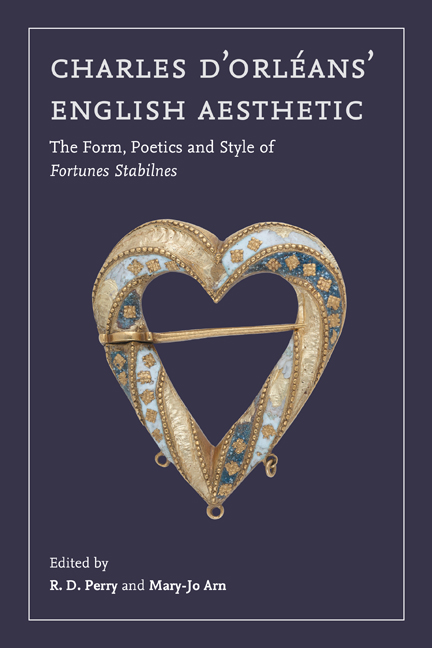Book contents
- Frontmatter
- Dedication
- Contents
- List of Illustrations
- List of Contributors
- Acknowledgements
- Abbreviations
- Introduction
- 1 The Two Dreams of Charles d’Orléans and the Structure of His English Book
- 2 Charles d’Orléans’ Cross-Channel Poetics: The Choice of Ballade Form in Fortunes Stabilnes
- 3 The English Roundel, Charles’s Jubilee, and Mimetic Form
- 4 A Grieving Lover: The Work of Mourning in Charles’s First Ballade Sequence
- 5 Charles d’Orléans’ English Metrical Phonology
- 6 The English Poetry of a Frenchman: Stress and Idiomaticity in Charles d’Orléans
- 7 Verb Use in Charles d’Orléans’ English
- 8 Charles d’Orléans and His Finding of English
- 9 Aureation as Agon: Charles d'Orléans versus John Lydgate
- 10 Charles d’Orléans, Harley 682, and the London Book-Trade
- 11 The Form of the Whole
- Select Publications, 2007–2020
- Index
11 - The Form of the Whole
Published online by Cambridge University Press: 14 October 2020
- Frontmatter
- Dedication
- Contents
- List of Illustrations
- List of Contributors
- Acknowledgements
- Abbreviations
- Introduction
- 1 The Two Dreams of Charles d’Orléans and the Structure of His English Book
- 2 Charles d’Orléans’ Cross-Channel Poetics: The Choice of Ballade Form in Fortunes Stabilnes
- 3 The English Roundel, Charles’s Jubilee, and Mimetic Form
- 4 A Grieving Lover: The Work of Mourning in Charles’s First Ballade Sequence
- 5 Charles d’Orléans’ English Metrical Phonology
- 6 The English Poetry of a Frenchman: Stress and Idiomaticity in Charles d’Orléans
- 7 Verb Use in Charles d’Orléans’ English
- 8 Charles d’Orléans and His Finding of English
- 9 Aureation as Agon: Charles d'Orléans versus John Lydgate
- 10 Charles d’Orléans, Harley 682, and the London Book-Trade
- 11 The Form of the Whole
- Select Publications, 2007–2020
- Index
Summary
What is Fortunes Stabilnes? Since Mary-Jo Arn's 1994 edition bestowed that title upon the Middle English poems attributed to Charles d’Orléans that survive in London, British Library, MS Harley 682, it has become easier to conceive of these heterogeneous writings as a ‘coherent whole’. A whole, however, is not a simple form. If there is coherence in Fortunes Stabilnes, it is richly plural: much of the dynamism that one encounters when reading this work derives from the ways in which different kinds of what we might call ‘coherence’ (narrative continuity, formal consonance, tonal regularity) emerge and recede, loosening and tightening their grip on the imagination of the poet as the work unfolds. As these principles of coherence fluctuate across the work, so too does the sense that the I of the text, the textual subject who appears in each of its constituent parts, might be read as a coherent individual, whether ‘autobi- ographical’ or ‘fictional’. Throughout Fortunes Stabilnes, then, the range of literary techniques that are used to give the impression of a bounded and coherent literary whole also prompt questions about how far a writer can, or might wish to, give the impression of a bounded and coherent self.
The first and largest part of this chapter is descriptive. I attempt to answer the question ‘what is Fortunes Stabilnes?’ by situating it in relation to some categories of late medieval writing. None of these, as will be seen, quite encapsulates the complexity of Charles's English work, but they help to bring into focus how Fortunes Stabilnes produces its strange and sometimes contrary effects. Since my contention is that the unity of Fortunes Stabilnes as a whole has profound effects on how a reader might understand the text's persona, I will bring out how the traditions within which Charles was working at once shore up and problematise the notion that the subject of Fortunes Stabilnes might be an autobiographical subject. The final part of this chapter zooms out slightly, placing Fortunes Stabilnes alongside the French poems that survive in Paris, Bibliothèque nationale de France, MS fr. 25458 – the ‘personal manuscript’ of Charles d’Orléans. Although Charles took this manuscript with him to France after his release in 1440, work was begun on it in England during his captivity, making it coeval with MS Harley 682.
- Type
- Chapter
- Information
- Charles d’Orléans' English AestheticThe Form, Poetics, and Style of Fortunes Stabilnes, pp. 265 - 287Publisher: Boydell & BrewerPrint publication year: 2020



